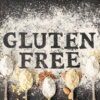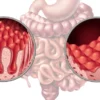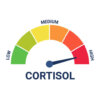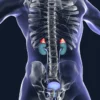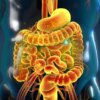
What is Gastritis?
Gastritis is a common digestive condition that impacts a significant percentage of the global population. This is where there is inflammation in the stomach that leads to a range of symptoms that include discomfort and burning pain.
While there are several possible causes and ways to relieve the burning pain seen in gastritis, there are a range of symptoms that are commonly seen in gastritis. [Source: PubMed]
These symptoms of gastritis include:
- Burning pain in the stomach
- Nausea
- Vomiting
- Burping or hiccups
- Reduced appetite
In more severe situations where the stomach lining is bleeding, blood may be found in the vomit or the stool. [Source: John Hopkins]
Many over-the-counter supplements and medications are available to address gastritis and pain. These can be helpful in the short term to manage symptoms of gastritis and burning pain.
It’s also important to address the underlying issue or combination of issues that are contributing to the symptoms in the first place.
What Causes Gastritis?
One of the main causes of gastritis is H. pylori. This has been found to be the cause of gastritis in up to 90% of cases. This bacterium can lead to inflammation in the lining of the stomach which primarily takes place in the upper layers of the mucosal lining.
This bacteria can be found within the digestive tract of many people without it actually being an issue. However, in the right circumstances, it can present as a problem and lead to symptoms.
The development and the severity of the symptoms associated with this may depend on the specific strain of H. pylori and how much it may influence the inflammatory and immune process and therefore contribute to gastritis pain.
The development of gastritis can be gradual with lead to the onset of burning pain. In many cases, the issue can begin in childhood with varying degrees of low-level inflammation in the lining of the stomach.
This may then develop over years which leads to the loss of the normal functioning of the lining of the stomach. This can lead to the growth of abnormal cells within the stomach and increased inflammation and pain. [Source: PubMed]
Other causes of gastritis include:
- Traumatic stress
- Autoimmune conditions
- High use of NSAIDs (non-steroidal anti-inflammatory drugs)
- Crohn’s disease
- Infections [Source: PubMed]
What is Autoimmune Gastritis?
While the main cause of gastritis is H. pylori it is possible for gastritis to be due to an autoimmune process taking place. In this situation, inflammation is noted alongside reduced stomach acidity with the presence of autoantibodies.
In autoimmune gastritis, these autoantibodies are against parietal cells and/or intrinsic factors. This autoimmune process can then lead to damage to the gut lining and/or reduced absorption of vitamin B12.
It is unclear if this form of gastritis and pain is an independent disorder of the type of gastritis and pain that is from H. pylori. It has been seen that in susceptible individuals H. pylori may trigger the onset of the autoimmune process.
However, gastritis that is caused by autoimmunity will likely be faster in its onset and its severity when compared to the caused by H. pylori. [Source: PubMed]
Can Gastritis Cause Stomach Cancer?
The more severe forms of gastritis (such as atrophic gastritis) will not only likely lead to increased pain but can also increase the risk of developing stomach cancer. Atrophic gastritis is indicated to put those at a higher risk of developing stomach cancer when compared to those with an H. pylori infection.
This is where the risk of developing stomach cancer increases significantly with the development of gastritis from a non-atrophic form to an atrophic form. Depending on the location of the gastritis and pain, this increase may be 90-fold. [Source: PubMed]
When comparing the risk of stomach cancer between those with a healthy stomach lining to those with an H. pylori infection (without atrophy) the increase in risk of stomach cancer may be 2-fold. While this risk does increase, it is still low when compared to those with atrophic gastritis. [Source: PubMed]
What Soothes a Gastritis Stomach Pain?
There are several ways to support and soothe the pain found in gastritis. These can be to avoid certain foods that may trigger symptoms but also include products and approaches that can soothe the gastritis pain.
There are key natural supplements that have been researched and found to support the healing of the gut and reduce gastritis pain.
With any approach, there may be the need to address an underlying cause of the gastritis. This may be related to H. pylori, a food reaction as well as potential stress. However, with the ongoing nature of symptoms of pain, support is often needed during and following these other areas being addressed. [Source: PubMed]
The factors that can soothe and address gastritis stomach pain include:
- Activated charcoal
- Zinc carnosine
- Aloe vera
- Licorice (DGL)
- Papaya
- L-Glutamine
- Slippery elm [Source: PubMed]
Zinc Carnosine for Gastritis Pain
Zinc carnosine (ZnC) is a combination of zinc and l-carnosine. Research studies have supported its use in restoring the health of the gastric lining and improving a range of other digestive conditions. These include oral mucositis and gastric ulcers.
This is likely due to the anti-inflammatory and antioxidant functions of these supplements. Reducing inflammation can support the healing process and reduce pain. [Source: PubMed]
Papaya for Gastritis Pain
Papaya can help reduce gastritis pain. This is understood to be due to papaya’s antioxidant activity.
This may also be due to its impact on smooth muscle and motility. Studies have also found papaya to be helpful for symptoms such as constipation, heartburn and IBS. [Source: PubMed]
Marshmallow for Gastritis Pain
Marshmallow root has been studied in relation to upper gut issues such as heartburn and gastric ulcers. This herb is high in antioxidants which are understood to play a central role in the benefits seen with this herbal medicine.
Part of the mechanisms involved in this herbal medicine improving upper gut symptoms such as heartburn and pain, is via the protection of the gut lining from further damage. It has also been found to support the healing of existing damage. [Source: PubMed]
Natural Treatment for Gastritis and H Pylori.
When gastritis and pain are present, it is also important to understand and address the underlying cause of gastritis. For example, if H. pylori is present this may be the area of focus. For some, antibiotics may be required.
There are also natural approaches to treat H. pylori that include:
- Deglycyrrhizinated Licorice (DGL) [Source: PubMed]
- Mastic Gum [Source: PubMed]
- Probiotics [Source: PubMed]
- Zinc carnosine [Source: PubMed]
- Broccoli sprouts [Source: PubMed]
- Herbal antimicrobials [Source: PubMed]
- Green tea [Source: PubMed]
- Sodium butyrate [Source: PubMed]
Can I Take Paracetamol for Gastritis Pain?
Paracetamol is considered to be a very safe pain-reducing medication. When studied, in digestive conditions, it’s been found to not contribute to symptoms such as digestive ulcers. This means that paracetamol is generally considered to be safe for those at high risk of developing digestive complications such as ulcers, pain or gastric bleeds. However, there may who may need to be cautious when this medication is taken at high doses for digestive issues and pain.
When compared to NSAID medication (such as ibuprofen) paracetamol does not cause injury to the lining of the digestive tract. This means that paracetamol is considered the preferred pain-reducing medication for those with gut-related risk factors.
Those taking paracetamol do occasionally report some symptoms from taking this medication. This can be in the form of upper GI symptoms commonly referred to as dyspepsia. This can include symptoms such as heartburn, nausea and epigastric discomfort.
So, while it may not induce any damage to the gut lining, a small percentage of those taking paracetamol for gut pain may experience dyspepsia. [Source: PubMed]
How Long Does Gastritis Take to Heal?
The time that it takes to heal gastritis can vary between individuals and can be influenced by a variety of factors. The time it takes to heal gastritis can be influenced by the underlying cause of the inflammation in the stomach, other health conditions as well as the use of certain medications.
It is also important to consider that certain forms of gastritis are considered to be chronic in nature. While there are many ways to support the gut to reduce these symptoms and improve the health of the gut, for some patients, the may need to be ongoing symptom management.
This type of symptom management can be helpful to keep pain at the lowest possible levels and prevent inflammation in the gut leading to longer-term and more serious digestive issues in the stomach. [Source: PubMed]
The Best Diet for Gastritis Pain
A range of foods and dietary patterns have been associated with increasing the severity of gastritis and the pain associated with gastritis.
This can include certain foods that may trigger symptom severity but also contribute to the ongoing process involved in gastritis.
A 2020 study reported that 58% of participants found that their symptoms were impacted by specific dietary patterns. This may be due to specific triggers being unclear to participants and they may require professional assistance to identify triggers. [Source: PubMed]
It is also possible for there to be delayed reactions to foods that can increase the inflammatory response in the gut. This can be another factor contributing to the challenge of identifying food triggers. [Source: PubMed]
The specific areas and symptoms researched that may increase in gastritis are:
- Stomach-ache/pain
- Hiccups/belching
- Heartburn
- Gastric distention
- Acid reflux
- Nausea
For each of these symptoms, specific groups of influencing factors were reported.
Factors that Increase Stomach-ache/pain
- Fried foods
- Spicy foods
- Irregular mealtimes
- Eating out in restaurants
- Sour foods
- Sweets
- Snacks
- Pickled foods
- Meats
- Salty foods
- Barbecue
- Irregular meal sizes
Factors that Increase Hiccups/belching
- Very hot foods
- Eating leftover food
- Pickled foods
- Meats
- Eating too fast
- Snacks
- Barbecue
- Irregular mealtimes
- Fried foods
- Sweets
Factors that Increase Heartburn
- Salty foods
- Sweets
- Meats
- Eating too fast
- Irregular mealtimes
Factors that Increase Gastric Distention
- Sour foods
- Eating out in restaurants
- Irregular meal sizes
- Fried foods
- Barbecue
- Salty foods
- Irregular mealtimes
- Eating leftover food
- Sweets
- Meats
- Snacks
Factors that Increase Acid Reflux
- Sweets
- Eating too fast
- Very hot foods
- Eating leftover foods
- Irregular mealtimes
- Salty foods
- Pickled foods
Factors that Increase Nausea
- Sweets
- Salty foods
- Irregular mealtimes
- Spicy foods
- Meats
- Eating leftover food [Source: PubMed]
Best Time to Eat for Gastritis Pain
Eating habits and food timing are 2 factors that can increase symptoms of gastritis pain as well as other digestive symptoms.
In particular, eating at irregular mealtimes can increase both nausea and stomach pain.
This may be due to the disruption in the circadian rhythm (the sleep/wake cycle). Alterations in this rhythm have been reported in several studies and repeatedly found to increase symptoms such as pain.
The way in which modern lifestyles impact the circadian rhythm can be a significant factor and reason for digestive conditions and their increase in the general population.
Therefore, eating at regular mealtimes is a key way to support digestive health and function. [Source: PubMed]
How to Relieve Gastritis Pain with Herbal Teas
A variety of teas may help to reduce the pain that comes along with gastritis but also help to heal and repair the gut lining.
Artemisia (Mugwort) and green tea have both been used to address gastritis. A 2018 animal study concluded that extracts of these 2 plants possess strong antioxidant and anti-inflammatory properties that can support the gut lining.
This was reported to help protect against H. pylori-associated gastric conditions as well as offer protection against gastritis that resulted from high alcohol intake. The study also found that this combination was helpful in repairing the gut if gastritis was present. This is likely due to the antioxidant and anti-inflammatory properties of these teas. [Source: PubMed]
Antioxidants have also been found in another study to help reduce inflammation and pain in gastritis. Kaempferol was found to reduce inflammation and pain in those with gastric pain.
This beneficial plant compound is found in high amounts in teas but also in fruits, vegetables and beans.
Some of the plants with the highest concentration of Kaempferol include capers, kale, dill, broccoli, witch-hazel, grapefruit, cabbage, beans, endive, leek, tomato, strawberries, grapes, Brussels sprouts and apples. [Source: PubMed]
How to Relieve Gastritis Burning Pain Fast
There are several ways gastritis burning pain can be reduced quickly. While this can help to manage the burning pain in gastritis, this form of symptom management may not get to the underlying issue in the stomach.
Working with a registered nutritional therapist is an important way to personalise the approach, not only to reduce symptoms but to identify and address the underlying issue in the gut.
This is with the aim not only to relieve the gastritis burning pain in the short term but to address the underlying issue/root cause of symptoms so they do not return.

